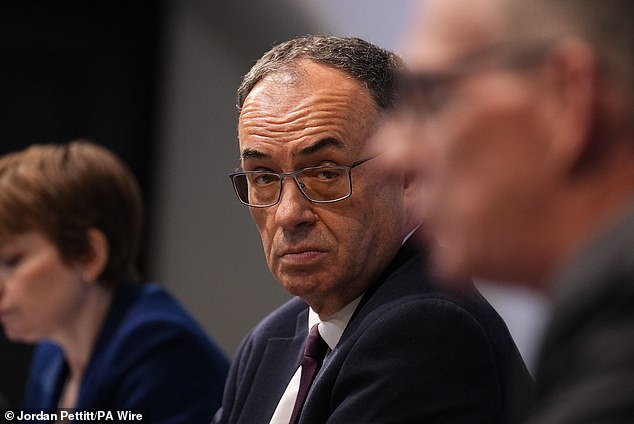The August 2025 session of the Bank of England’s interest rate-setting Monetary Policy Committee (MPC) is one for the connoisseurs.
Not since the Bank gained its independence way back in 1997, when Gordon Brown was at Number 11, has the MPC required two votes to reach a decision.
What makes that even more remarkable is that the intervening 28 years have been some of the most turbulent in modern financial history with the Great Financial Crisis of 2008, the pandemic, Russia’s war in Ukraine and tariff mayhem.
The Bank’s insiders were as divided in this week’s session as the external MPC members. This indicates the age of ‘group think’ may have passed.
It also suggests that governor Andrew Bailey is increasingly out of step with his colleagues.
The two most senior economic gurus at the Bank, chief economist Huw Pill and deputy governor for monetary policy Clare Lombardelli, plainly had concerns.

Cautious: Bank of England Governor Andrew Bailey has been preparing the markets and the public for a rate cut for several weeks in public comments
They were troubled about easing policy with a quarter-of-a-percentage point cut to 4 per cent when consumer prices are still on an upward trend.
The Bank forecasts that headline inflation will peak at 4 per cent next month before heading downwards.
But the blunt caution in the inflation report about the impact of the employers’ National Insurance hike and minimum wage on inflation suggests the wait for a further lowering of rates will be longer than expected.
The benchmark ten-year yield on government bonds, or gilts, climbed to 4.56 per cent in Thursday trading. Over the last year, it has risen 15.67 per cent.
Chancellor Rachel Reeves argues that it is fiscal stability which has allowed the Bank to deliver five rate cuts since Labour came to office.
Yes, the Government offers the markets some political stability because of its large majority, but there can be no claim of budgetary steadiness.
Reeves’s narrow £10billion of headroom, or fiscal space, in last October’s budget was wiped out long ago.
And the black hole grows ever bigger because of subsiding growth and a higher interest rate cost for the national debt.
Bailey often appears as concerned about Britain’s economy capsizing as fighting inflation. That’s why the Bank was slow to raise rates after the pandemic and Ukraine.
It continued to print money (quantitative easing) despite a negative vote from its former chief economist Andy Haldane.
Bailey has been preparing the markets and the public for a rate cut for several weeks in public comments.
So to have been among the hawks on a divided committee was not really an option given his fraying credibility.
His cautious words, talking of a ‘gradual and careful’ approach, show that he is being reined in by his own colleagues.
Pill and Lombardelli, both of whom might feel they have a shot at the top job in 2028, would not want to be on the wrong side of an inflation spurt.
The Inflation Report is definitive on a softening of the labour market, even though the data is still uncertain.
It also notes, however, that average private sector wages are running at just under 5 per cent.
Over-generous awards to the public sector, seen in the immediate aftermath of the election, when some £9.4billion extra was handed out, show the Government can’t be relied upon to keep the lid on union demands.
Just how divided opinion has become about the state of the economy comes from Professor Alan Taylor of Columbia University, the newest member of the committee, who became a super-dove with his vote for a half-point cut.
The Bank marginally increased its growth forecast for 2025 to 1.2 per cent from 1.1 per cent in line with the International Monetary Fund.
Taylor is unconvinced and plainly felt that if rates are held too high for too long there is a genuine recession risk.
Normally in Britain, consumers have a high propensity to spend. Confidence is at a low ebb and citizens are far more cautious than in the past.
Whether a quarter-point cut in the bank rate will persuade them to spend, rather than accept lower returns on their cash ISAs and savings accounts, is a moot point.
The prospect of further swingeing tax increases will weigh heavily on behaviour.
DIY INVESTING PLATFORMS

AJ Bell

AJ Bell
Easy investing and ready-made portfolios

Hargreaves Lansdown

Hargreaves Lansdown
Free fund dealing and investment ideas

interactive investor

interactive investor
Flat-fee investing from £4.99 per month

InvestEngine

InvestEngine
Account and trading fee-free ETF investing
Trading 212
Trading 212
Free share dealing and no account fee
Affiliate links: If you take out a product This is Money may earn a commission. These deals are chosen by our editorial team, as we think they are worth highlighting. This does not affect our editorial independence.
This article was originally published by a www.dailymail.co.uk . Read the Original article here. .

